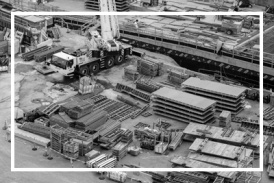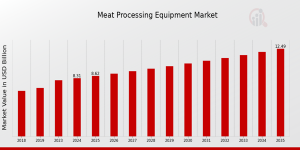Meat Processing Equipment Market to Witness Steady Growth Through 2035Driven by Rising Demand for Processed Meat Product
Meat Processing Equipment Market Research Report By Application, By Type, By End Use, By Mode of Operation and By Regional -Forecast to 2035
NEW YORK, NY, UNITED STATES, May 2, 2025 /EINPresswire.com/ -- The global Meat Processing Equipment Market is set to experience consistent growth through 2035, driven by increasing demand for processed meat products, technological innovations in food machinery, and growing investments in food safety and automation. As consumer preferences continue to shift toward convenient, ready-to-cook, and packaged protein-rich foods, meat processors and manufacturers are upgrading their production capabilities using advanced equipment to enhance efficiency, hygiene, and output quality.According to the latest insights from Market Research Future, the meat processing equipment market is segmented based on application, type, end use, mode of operation, and regional distribution. Each segment reflects evolving trends and plays a significant role in shaping the industry's future.
The Meat Processing Equipment Market was valued at USD 8 billion in 2023 and is projected to grow to USD 8.31 billion in 2024. By 2035, the market is expected to reach USD 12.5 billion, expanding at a compound annual growth rate (CAGR) of approximately 3.78% during the forecast period from 2025 to 2035.
Market Segmentation Overview
By Application: Meat Preparation, Meat Preservation, Meat Packaging, Meat Processing
The market’s division by application highlights the diverse roles equipment plays in the meat value chain:
Meat Preparation Equipment includes machines used for cutting, mixing, marinating, and tenderizing meat. These tools are essential in standardizing meat quality and flavor in processed food products.
Meat Preservation Equipment is vital in ensuring food safety and extending shelf life. Equipment such as vacuum sealers and cold storage systems helps in reducing spoilage, contamination risks, and bacterial growth.
Meat Packaging Equipment addresses consumer demand for portioned, convenient, and tamper-proof packaging. With rising environmental concerns, manufacturers are increasingly adopting sustainable packaging technologies.
Meat Processing Equipment involves grinding, slicing, forming, and cooking machines. These are critical for creating sausages, patties, cured meats, and other processed forms that dominate retail shelves and food service menus globally.
"Free Sample Copy" - Access a complimentary copy of our report to explore its content and insights: https://www.marketresearchfuture.com/sample_request/21807
By Type: Slicing Machines, Grinders, Mixers, Forming Machines
The equipment type segment focuses on specific machinery driving processing efficiency:
Slicing Machines are indispensable in high-volume operations, ensuring uniformity and reducing wastage. Innovations in blade technology and automation are boosting this segment.
Grinders remain crucial in producing minced meat products. Enhanced safety features and hygiene compliance have become key focus areas for manufacturers.
Mixers are widely used in blending spices and additives into meat. They contribute significantly to product flavor and consistency.
Forming Machines are witnessing rising demand, especially from burger and sausage manufacturers. These machines shape meat products into standardized forms, ideal for fast-food chains and mass retailing.
By End Use: Commercial Meat Processors, Retail Outlets, Food Service Industry
Different end-use sectors have specific equipment needs:
Commercial Meat Processors represent the largest end-user group. These enterprises require robust, high-capacity equipment to meet industrial-scale demand while complying with stringent food safety norms.
Retail Outlets such as supermarkets, hypermarkets, and butcher shops are adopting compact, easy-to-operate machines for on-site meat preparation and packaging.
Food Service Industry, including hotels, restaurants, and institutional kitchens, increasingly utilizes semi-automated equipment to balance productivity and space constraints. The trend toward centralized kitchens in foodservice chains further boosts demand.
By Mode of Operation: Manual, Semi-Automatic, Fully Automatic
Manual Equipment is primarily used by small-scale butchers and meat retailers in emerging markets. It requires skilled labor but has lower upfront investment.
Semi-Automatic Equipment is popular among mid-sized meat processors who seek a balance between operational control and improved efficiency. It remains a flexible solution for businesses in transition.
Fully Automatic Equipment is gaining rapid traction due to its superior efficiency, minimal labor requirements, and high output. With Industry 4.0 integration, many processors are shifting toward smart, IoT-enabled machinery for real-time monitoring, predictive maintenance, and automated control systems.
"Proceed to Buy" - Move forward with your purchase and gain instant access to the complete report : https://www.marketresearchfuture.com/checkout?currency=one_user-USD&report_id=21807
Regional Insights: North America, Europe, Asia Pacific, South America, Middle East and Africa
North America holds a leading position in the global meat processing equipment market, fueled by advanced meat processing industries, strong demand for convenience foods, and the presence of major market players in the U.S. and Canada.
Europe follows closely, with countries like Germany, France, and the UK investing heavily in food safety compliance and automation. The region’s focus on sustainable meat production also influences equipment innovation.
Asia Pacific is the fastest-growing region, driven by rising urbanization, growing middle-class populations, and shifting dietary patterns in countries like China, India, and Japan. As meat consumption surges, local and international players are expanding operations and upgrading processing infrastructure.
South America, particularly Brazil and Argentina, shows promising growth due to their large meat production and export industries. Modernizing outdated equipment in this region presents significant opportunities for manufacturers.
Middle East and Africa are emerging markets where halal meat processing is dominant. As these regions urbanize and foodservice sectors expand, investments in modern meat processing equipment are rising steadily.
Industry Developments
The meat processing equipment industry has witnessed a wave of innovation and expansion in recent years
Smart Processing Technology: Industry 4.0 is revolutionizing meat processing by integrating sensors, robotics, AI, and data analytics into equipment systems. Real-time monitoring helps reduce downtime, increase yields, and ensure quality control.
Sustainability Initiatives: Manufacturers are focusing on energy-efficient machinery and developing equipment compatible with biodegradable and recyclable packaging materials. Water and energy conservation are becoming central to equipment design.
Hygiene and Safety Compliance: With increasing global food safety regulations, manufacturers are incorporating hygienic design principles—easy-to-clean surfaces, antimicrobial materials, and automation to minimize human contact.
Customization and Flexibility: Equipment is increasingly being designed for multi-functionality and modularity, enabling processors to switch between products or meat types without costly downtime or machine replacements.
"Discover Competitive Analysis" - Gain a competitive edge by exploring our comprehensive competitive analysis, understanding the market positioning of key players and their strategies : https://www.marketresearchfuture.com/reports/meat-processing-equipment-market-21807
Key Trends
Several trends are shaping the future of the meat processing equipment market:
Rising Demand for Processed Meat: Urban lifestyles and increasing disposable incomes are fueling consumption of packaged, ready-to-cook, and frozen meat products. This is directly boosting demand for high-capacity, high-efficiency processing equipment.
Growth in Plant-Based Meat Alternatives: Interestingly, equipment originally used for meat processing is being adapted for plant-based protein products. Forming machines and mixers are being redesigned to accommodate soy, pea, and mycoprotein-based formulations.
Adoption of Clean Label and Natural Processing: As consumers seek minimally processed meats with fewer additives, manufacturers are investing in equipment that supports natural preservation methods such as vacuum packing, steam cooking, and fermentation.
Globalization of Food Chains: As global trade in meat products increases, food safety, traceability, and packaging innovations are becoming more critical—thereby driving demand for advanced processing and monitoring equipment.
Market Drivers
Urbanization and Lifestyle Changes: Rapid urbanization and changing eating habits are increasing the consumption of processed and packaged meat products, particularly in developing economies.
Labor Shortages and Cost Pressures: Rising labor costs and shortages in skilled workers are prompting meat processors to automate operations wherever possible.
Stringent Food Safety Regulations: Compliance with global food safety standards such as HACCP, ISO, and FDA regulations is driving investments in advanced, hygienic, and traceable processing systems.
Global Expansion of Quick Service Restaurants (QSRs): The global rise in fast-food chains and food delivery services demands consistency, speed, and large volumes of processed meat products—further supporting market growth.
Challenges
Despite its promising outlook, the meat processing equipment market faces several hurdles:
High Capital Investment: The cost of advanced, automated systems remains a barrier for small and medium-sized processors, especially in developing markets.
Maintenance and Operational Complexity: Automated and smart machines require regular maintenance and skilled operators, which can be a challenge in regions with limited technical expertise.
Stringent Import Regulations: Cross-border trade in food equipment is often subject to complex customs procedures, certifications, and regulatory clearances that delay market entry.
Consumer Concerns Around Meat Consumption: Health and ethical concerns around meat consumption, especially red and processed meat, can impact overall market dynamics, prompting equipment manufacturers to diversify into plant-based processing systems.
The global meat processing equipment market is on a solid growth trajectory, supported by rising demand for processed meat, increased focus on food safety, and advancements in automation. From slicing and grinding to packaging and preservation, modern meat processors rely heavily on efficient, hygienic, and scalable equipment solutions. As consumer preferences evolve and industry standards rise, equipment manufacturers who embrace innovation, sustainability, and flexibility are best positioned to lead this expanding market.
TABLE OF CONTENTS
EXECUTIVE SUMMARY
2 Market Introduction
3 RESEARCH METHODOLOGY
4 MARKET INSIGHTS
5 Market Dynamics
6 Market Factor Analysis
Discover more Research Reports on Food, Beverages & Nutrition Industry, by Market Research Future:
Durian Chocolate Market: https://www.marketresearchfuture.com/reports/durian-chocolate-market-7247
Quinoa Seeds Market: https://www.marketresearchfuture.com/reports/quinoa-seeds-market-7261
Bromelain Market: https://www.marketresearchfuture.com/reports/bromelain-market-7266
Dairy-free Yogurt Market: https://www.marketresearchfuture.com/reports/dairy-free-yogurt-market-7320
Gluten-free flours Market: https://www.marketresearchfuture.com/reports/gluten-free-flours-market-7327
Detox Drinks Market: https://www.marketresearchfuture.com/reports/detox-drinks-market-7330
Beverage Stabilizers Market: https://www.marketresearchfuture.com/reports/beverage-stabilizers-market-7334
Cashew Milk Market: https://www.marketresearchfuture.com/reports/cashew-milk-market-7352
About Market Research Future:
Market Research Future (MRFR) is a global market research company that takes pride in its services, offering a complete and accurate analysis with regard to diverse markets and consumers worldwide. Market Research Future has the distinguished objective of providing optimal quality research and granular research to clients. Our market research studies by products, services, technologies, applications, end users, and market players for global, regional, and country level market segments, enable our clients to see more, know more, and do more, which help answer your most important questions.
Contact Us:
Market Research Future (Part of Wantstats Research and Media Private Limited)
99 Hudson Street, 5Th Floor
New York, NY 10013
United States of America
+1 628 258 0071 (US)
+44 2035 002 764 (UK)
Email: sales@marketresearchfuture.com
Website: https://www.marketresearchfuture.com
Market Research Future
Market Research Future
+1 855-661-4441
email us here
Visit us on social media:
LinkedIn
Facebook
X
Legal Disclaimer:
EIN Presswire provides this news content "as is" without warranty of any kind. We do not accept any responsibility or liability for the accuracy, content, images, videos, licenses, completeness, legality, or reliability of the information contained in this article. If you have any complaints or copyright issues related to this article, kindly contact the author above.
Pogo Stadium Demo Launches for Steam Next Fest With Go-Inspired Rhythm Strategy and Shinobu Amayake Score
Talentuch Reports Groundbreaking Recruitment Case: Client Chooses AI Over Human Data Analyst
Electra Wins Audience Prize at WMF 2025 for Advancing Battery Intelligence with AI
Kalendarium
Więcej ważnych informacji
 Jedynka Newserii
Jedynka Newserii

 Jedynka Newserii
Jedynka Newserii

Transport

Import materiałów budowlanych z Rosji zagrożeniem dla konkurencyjności europejskiego rynku. Konieczne są zmiany i egzekwowanie sankcji
Unia Europejska powinna zrewidować politykę celną na import materiałów budowlanych spoza państw członkowskich, w tym państw wschodnich – twierdzą uczestnicy konferencji „Bezpieczeństwo gospodarcze UE”. Obecnie Wspólnota nakłada na europejskich producentów coraz więcej ograniczeń, nie rewidując polityki celnej, co przekłada się na systematyczne osłabienie konkurencyjności przedsiębiorstw, spadek produkcji i zagrożenie dla miejsc pracy.
Konsument
Polacy odczuwają brak wiedzy na temat inwestowania. Może to sprzyjać podejmowaniu nieracjonalnych decyzji finansowych

Co trzeci Polak odczuwa brak wiedzy w obszarze inwestowania, a tylko co piąty chciałby pogłębić swoją wiedzę na ten temat – wynika z badania „Poziom wiedzy finansowej Polaków 2025”. Ci, którzy na własną rękę szukają informacji i porad, coraz częściej sięgają do blogów, portali, podcastów i wideo w internecie. Eksperci przestrzegają, że finansowych i inwestycyjnych porad udzielają nie tylko specjaliści w danej dziedzinie, więc potrzebna jest zasada ograniczonego zaufania.
Handel
Do 2030 roku liczba plastikowych opakowań w e-handlu modowym może się podwoić. Ich udział najszybciej rośnie w Polsce

Wraz ze wzrostem kanału e-commerce w branży modowej rośnie liczba wykorzystywanych opakowań, z których znaczną część wciąż stanowią te z plastiku. Do 2030 roku w Polsce e-sprzedawcy zużyją 147 mln plastikowych opakowań – wynika z badania przeprowadzonego na zlecenie DS Smith. Można zauważyć rosnący trend wśród marek modowych, które coraz częściej wybierają opakowania wykonane z papieru lub materiałów z recyklingu. To o tyle istotne, że polscy konsumenci odczuwają wyrzuty sumienia z powodu ilości plastiku, w którym dostarczane są ich zamówienia.
Partner serwisu
Szkolenia

Akademia Newserii
Akademia Newserii to projekt, w ramach którego najlepsi polscy dziennikarze biznesowi, giełdowi oraz lifestylowi, a także szkoleniowcy z wieloletnim doświadczeniem dzielą się swoją wiedzą nt. pracy z mediami.









.gif)

 |
| |
| |
|